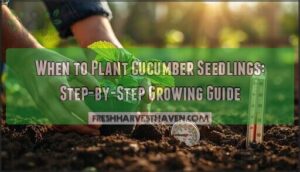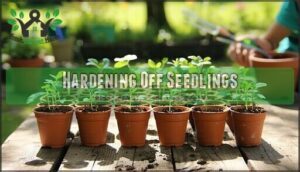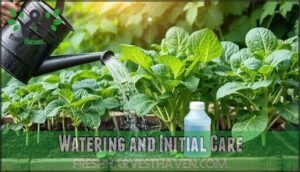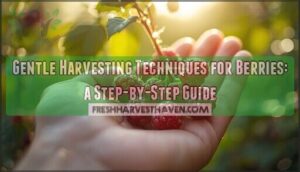This site is supported by our readers. We may earn a commission, at no cost to you, if you purchase through links.

Your seedlings should have 2-3 sets of true leaves before transplanting, which happens about 3-4 weeks after starting seeds indoors. Cold soil stunts growth faster than a cucumber vine climbs a trellis, so patience pays off.
The secret lies in timing your indoor seed starting perfectly with your local growing conditions.
Table Of Contents
- Key Takeaways
- When to Plant Cucumber Seedlings Outdoors
- Starting Cucumber Seeds Indoors
- Preparing Soil and Containers for Planting
- Transplanting Cucumber Seedlings Step-by-Step
- Tips for Healthy Growth and a Bountiful Harvest
- Frequently Asked Questions (FAQs)
- How do you plant a cucumber plant?
- Should you plant cucumbers from seed?
- When can I plant cucumber seeds?
- When should I transplant cucumber seedlings?
- What month do you start planting cucumbers?
- Can cucumber grow in September?
- Can you plant cucumber seedlings deeper?
- Can cucumber seedlings survive unexpected late frost?
- How often should seedlings be watered daily?
- What companion plants work best with cucumbers?
- Conclusion
Key Takeaways
- Wait for warm soil and no frost risk – Don’t plant your cucumber seedlings outdoors until the soil consistently reaches 60-70°F and you’re past your area’s last spring frost date. Typically, wait 1-2 weeks after the final frost for safety.
- Start seeds indoors 3-4 weeks before transplanting – You’ll get the best results by starting your cucumber seeds indoors about 3-4 weeks before your last frost date, giving seedlings time to develop 2-3 sets of true leaves before moving them outside.
- Harden off seedlings gradually – You can’t just move seedlings straight from indoors to your garden. Spend 7 days gradually exposing them to outdoor conditions, starting with 2 hours in filtered light and increasing daily exposure.
- Focus on consistent care after transplanting – Once your seedlings are in the ground, they’ll need regular watering (about 1 inch weekly), proper trellising support, and monthly fertilization to produce a bountiful harvest throughout the growing season.
When to Plant Cucumber Seedlings Outdoors
You’ll want to plant your cucumber seedlings outdoors after the last spring frost date, when soil temperatures consistently reach 60°F to 70°F.
This timing ensures your seedlings won’t face frost damage and can establish strong root systems in warm soil conditions.
Checking Last Spring Frost Dates
Before planting cucumber seedlings, you’ll need to check your last spring frost date to avoid cold damage. This critical timing data helps determine when it’s safe to transplant outdoors.
Historical frost trends show the growing season has lengthened, with last spring frost dates occurring about three days earlier since 1980. To ensure proper germination, remember that cucumber seeds need warmth. However, data source reliability varies, so cross-reference multiple sources for accurate planning.
- Check USDA Plant Hardiness Zone maps – These provide regional frost date averages based on historical climate data
- Contact local agricultural extension offices – They offer county-specific freeze data with monthly updates
- Use National Weather Service online tables – Interactive maps show frost probability by date and location
- Account for microclimate variations – Your yard may differ from regional averages by several degrees
- Add a planting date buffer – Wait 1-2 weeks after the last frost date for consistent soil warmth
Monitoring Soil Temperature
You’ll need a soil thermometer to check ground temperature before planting cucumber seedlings. Cold soil effects include poor germination and stunted growth. Best germination temps range from 60-75°F.
Use heating soil methods like black plastic mulch or row covers for temperature consistency impact. Spring planting timing depends on reaching these temperatures consistently.
Regional Planting Windows
Your climate zone determines your cucumber planting window. Zone 6 gardeners transplant in mid-May to early June, while Zone 9 allows late February planting. Microclimates impact local conditions greatly.
Cucumbers generally thrive in USDA hardiness zones 4 through 12. Check with local nurseries for regional variations in your growing season, as spring planting timing varies dramatically across regions.
Starting Cucumber Seeds Indoors
You’ll want to start your cucumber seeds indoors about 3 to 4 weeks before your area’s last spring frost date, which gives seedlings enough time to develop strong root systems and mature leaves.
Starting seeds indoors allows you to control germination conditions, making sure soil temperatures stay between 70°F and 80°F for best sprouting within 3 to 7 days.
When to Start Seeds Indoors
- Temperature control: Use seedling heat mats to maintain 70-80°F for best germination
- Light requirements: Provide 12-14 hours of bright light daily once seeds sprout
- Container size: Choose 3-4 inch pots with drainage holes for healthy root development
Materials and Setup Needed
Getting started with seeds means picking up a few key supplies. The size of your containers makes a real difference for root growth, and mixing in some compost will give your soil the boost it needs.
Grab some quality seed starting mix, biodegradable pots, and a simple soil test kit to check your pH levels.
| Essential Items | Purpose |
|---|---|
| Seed starting mix | Provides proper drainage and nutrients |
| Plantable pots (3-4 inch) | Allows direct transplanting without root disturbance |
| Soil testing kits | Monitors pH levels (6.0-7.0 ideal) |
Seed Germination Tips
Keep temperatures between 70-85°F to get your cucumber seeds sprouting in three to ten days. Plant them about half an inch deep in soil that stays consistently moist.
Check the soil daily and water gently so you don’t disturb the seeds. Fresh seeds will give you much better germination rates than old ones sitting in your drawer.
Yes, waiting for seeds to sprout tests your patience. But when you nail the basics—right temperature, proper depth, steady moisture—you’ll see those little green shoots pop up right on schedule.
Preparing Soil and Containers for Planting
You’ll need to test your soil pH using a testing kit, aiming for the slightly acidic to neutral range of 6.0 to 7.0 that cucumbers prefer for best nutrient uptake.
Choose containers that are at least 6-8 inches deep with drainage holes, and fill them with well-draining vegetable potting mix enriched with compost to provide the fertile foundation your seedlings need.
Ensuring Proper Soil PH and Fertility
Getting your cucumber seedlings off to a strong start comes down to nailing the soil conditions.
The pH sweet spot sits between 6.0-7.0 – that slightly acidic to neutral range where cucumbers really take off.
Here’s how to prepare soil for planting:
- Test soil pH using digital meters or test strips
- Add lime to raise pH or sulfur to lower it
- Mix compost or aged manure to boost organic matter
- Check for nutrient deficiency signs like yellowing leaves
- Apply balanced fertilizer following package directions
Proper soil testing methods reveal what your plants need before problems arise.
Choosing and Preparing Containers
When picking out your containers, think about how much room those roots need to stretch out and thrive. Go for something at least 8-12 inches deep with plenty of drainage holes – nobody wants soggy, waterlogged roots.
You’ve got options: plastic works fine, ceramic looks nice, or try those biodegradable pots you can plant right in the ground to avoid shocking your seedlings later.
Fill containers with high-quality potting mix enriched with compost. Position containers where cucumber seedlings receive 6-8 hours of sunlight access daily.
Transplanting Cucumber Seedlings Step-by-Step
Once your cucumber seedlings develop 2-3 sets of true leaves and soil temperatures consistently reach 65°F, you’re ready to transplant them outdoors.
Getting the timing and preparation right makes all the difference when moving your seedlings from indoors to the garden.
Hardening Off Seedlings
Before transplanting cucumber seedlings, you’ll need to toughen them up through hardening off. This temperature acclimation process involves gradual sun exposure over seven days.
Start with two hours outdoors in filtered light, then increase daily exposure while monitoring seedling health. Provide wind protection during this adjustment period.
Reduce watering adjustments slightly to prepare your cucumber seedlings for outdoor conditions.
Ideal Transplanting Time and Method
Get your timing right for cucumber transplants. Soil needs to hit 65-70°F consistently, and nights should stay above 50°F before you make the move.
Give each seedling 12-18 inches of breathing room and treat those roots like they’re made of glass – any damage sets them back weeks.
Pick a cloudy, still day for the job. Your seedlings will thank you when they don’t have to battle sun and wind while adjusting to their new home.
Watering and Initial Care
After planting your cucumber seedlings, proper watering becomes your top priority. Give them consistent moisture without waterlogging the soil.
Apply mulch around seedlings for moisture retention and temperature control.
Begin early fertilizing with diluted liquid fertilizer after one week.
Make certain adequate sun exposure while providing seedling protection from harsh afternoon heat.
Watch for transplant shock signs like wilting leaves.
Tips for Healthy Growth and a Bountiful Harvest
After getting your cucumber seedlings in the ground, the real work begins. Your plants need consistent care to produce those crisp, abundant cucumbers you’re after.
Consistent watering, adequate trellising, regular fertilization, and timely pest management will determine whether your plants thrive or struggle throughout the growing season.
Providing Support and Trellising
Setting up growth aids helps your vining plants reach their full potential. When you plant cucumbers, they’ll sprawl everywhere without proper guidance, making harvest a treasure hunt through tangled vines.
Essential trellis types for best vertical growth:
- A-frame trellises – Sturdy wooden structures for heavy cucumber loads
- Wire cages – Circular structures promoting improved airflow around plants
- String trellises – Simple vertical fixtures attached to overhead frames
- Cattle panels – Durable metal grids perfect for space optimization
- Bamboo teepees – Natural trellis options for smaller gardens
Growth aids improve harvesting ease while boosting your garden’s productivity.
Watering and Fertilization Schedule
Your cucumber plants need consistent watering to thrive. Water deeply once or twice weekly, providing about one inch total. Check soil moisture levels regularly—the top inch should feel slightly dry before watering again.
Fertilize monthly with balanced 10-10-10 fertilizer to prevent nutrient deficiencies and blossom end rot.
Good soil drainage prevents root problems, while consistent plant care ensures healthy growth.
Pest and Disease Prevention
Healthy cucumber plants start with getting ahead of problems before they take hold. Regular scouting catches issues early, saving you headaches down the road. Choose disease-resistant varieties when possible—they’re your first line of defense. Companion planting with herbs like basil or marigolds creates natural barriers that pests tend to avoid.
- Check weekly for pests using sticky traps and a careful look at your plants
- Use organic treatments like neem oil when you spot trouble brewing
- Rotate your crops each year to break disease cycles and give your soil a fresh start
Combining these approaches works better than relying on any single strategy.
Harvesting at The Right Time
Timing transforms good gardeners into great ones. You’ll know your cucumbers have reached maturity when they display proper color indicators and cucumber size. Harvest regularly every 1-2 days to guarantee a bountiful harvest and maintain ideal taste and texture.
Determining the right time requires checking daily. Storage after harvest keeps cucumbers fresh for weeks when refrigerated properly.
Frequently Asked Questions (FAQs)
How do you plant a cucumber plant?
Like ancient farmers tending Victory Gardens, you’ll dig a hole twice your seedling’s root ball width. Place the plant at soil level, backfill gently, then water thoroughly to settle roots.
Should you plant cucumbers from seed?
You can absolutely start cucumbers from seed! It’s cost-effective and gives you more variety choices.
Seeds germinate quickly in warm soil (60-80°F) within 3-10 days, making direct sowing simple and rewarding.
When can I plant cucumber seeds?
Plant cucumber seeds directly outdoors after soil reaches 60-70°F, usually late May to early June after your last spring frost.
You can start them indoors 3-4 weeks earlier for transplanting.
When should I transplant cucumber seedlings?
You’ll want to transplant cucumber seedlings when they’ve developed 2-3 sets of true leaves and soil temperatures consistently reach 60-65°F.
Wait until after your area’s last frost date to avoid cold damage.
What month do you start planting cucumbers?
Surprisingly, 90% of cucumber failures happen from poor timing.
Poor timing causes most cucumber growing failures, making proper planting schedules essential for garden success
You’ll start planting cucumbers in late May through early June, after soil temperature reaches 60-70°F and your last frost passes. This timing yields best germination.
Can cucumber grow in September?
Yes, you can grow cucumbers in September, but success depends on your climate zone. Planting cucumbers in August or September will prove most successful in warmer climates, such as USDA zones 8 through 10, where there’s enough time before frost.
Can you plant cucumber seedlings deeper?
I’ll help you with
Can cucumber seedlings survive unexpected late frost?
Cucumber seedlings can’t survive unexpected late frost. Temperatures below 32°F will damage or kill young plants.
You’ll need to cover them with row covers, blankets, or bring containers indoors when frost threatens.
How often should seedlings be watered daily?
Water your seedlings once daily when the top inch of soil feels dry.
Young plants need consistent moisture but not waterlogged conditions.
Check soil moisture with your finger before watering to avoid ovewatering disasters.
What companion plants work best with cucumbers?
Looking to increase your cucumber harvest through smart plant partnerships? Plant corn, radishes, marigolds, and dill alongside your cucumbers – these companions attract beneficial insects while deterring harmful pests, creating a thriving garden ecosystem naturally.
Conclusion
Getting cucumber timing right makes all the difference between a bumper crop and a frustrating season. Once you nail the temperature sweet spots, figure out your frost dates, and get transplanting down pat, you’re set up for success.
Start your cucumber seeds indoors, then move them outside when conditions are just right. Keep an eye on soil temps, ease those seedlings into outdoor life slowly, and don’t forget sturdy supports for climbing.
Do this right and you’ll be picking fresh, crunchy cucumbers all summer long.





